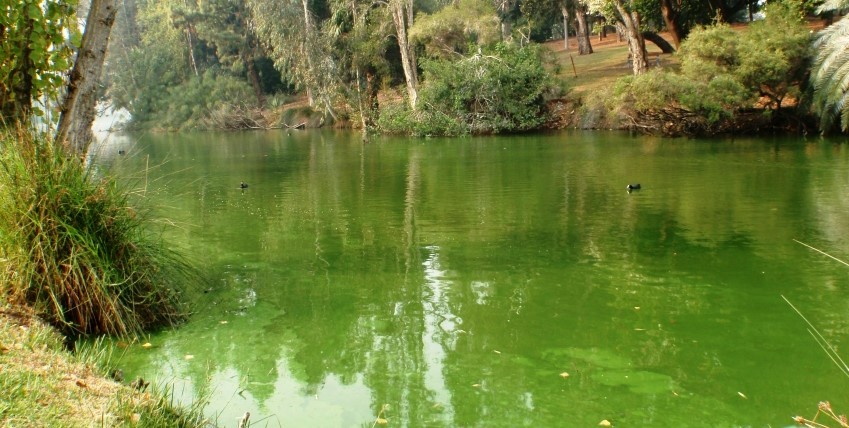Eutrophication means nutrient enrichment. It causes excess primary productivity (algal overgrowth) in waterways, resulting in poor water quality and reduced amenity, and in the worst cases, algal blooms, low oxygen and fish deaths.
Eutrophication can occur naturally but is a widespread problem as a result of human activities.
Nutrients are essential for the growth and survival of algae and aquatic plants, just as they are for terrestrial (land) plants. However, only small amounts of each nutrient are required in a natural ecosystem and any additional increase of these nutrients in waterways can quickly become a problem.
Why are there excess nutrients in our waterways?
Human activities have altered the way water moves through the landscape.
By clearing vegetation for agriculture or urban development, and by constructing drainage, water is moved more quickly off the catchment and into receiving waterways and water bodies, carrying with it excess sediment and nutrients.
This problem is exacerbated when extra nutrients are applied to the catchment in the form of fertiliser and animal manure, sewage, detergents or industrial effluent, and also by changing the types of plants present.
Where water passes slowly overland through vegetation or slowly through vegetated wetlands, rivers and estuaries, some of the sediment and nutrients can be trapped and absorbed.
However, all too often the fringing riparian vegetation around rivers and estuaries has also been removed or degraded, or water is moved rapidly through drainage channels, and there is insufficient opportunity for the removal of sediment and nutrients before they enter receiving waterways.
Compounds that contain nitrogen and phosphorus are the most common culprits causing eutrophication. In general these nutrients are not toxic at the concentrations typically found in nature, however they can have a large impact on the health of rivers and estuaries.
How does it impact our waterways?
High concentrations of nutrients encourage excessive algal growth and may result in nuisance or toxic algal blooms. Eventually when these blooms collapse and die, the resulting decomposition of the algal cells by bacteria removes oxygen from the water, sometimes causing mass fish kill events.
Nutrients are also temporarily stored in river and estuary sediments, but under certain environmental conditions, such as when there is low oxygen, the nutrients can re-enter the overlying water and be available again to grow more algae.
Eutrophication can stimulate the growth of algae to the extent that they begin to dominate an aquatic system, often to the exclusion of other species. Affected ecosystems lose their biodiversity, typically containing high populations of only a few plant species. Once simplified ecosystems occur, the natural cycling of nutrients in the system is interrupted and problems become persistent and recurring.
Eutrophication and algal overgrowth reduce water quality and affect the recreational use and enjoyment of our waterways. Common consequences are unpleasant odours, excessive nuisance insect production (e.g. mosquitoes and midges) and making them less suitable for swimming, boating and fishing.
What we do
Show moreExcess nutrients in run-off from fertiliser and effluent on agricultural land is the largest source of nutrients entering estuaries in south-west catchments.
Our Healthy Estuaries WA program works with catchment and industry groups and farmers to reduce the nutrient run-off from farms, improve water quality, and reduce incidents of algal blooms, low oxygen and fish deaths.
We assess the concentrations of nutrients at a range of sites in our south-west rivers and estuaries, stormwater drains and groundwater resources. Understanding the concentrations of nutrients both within and entering our rivers and estuaries helps us assess the health of waterways and determine management solutions to minimise the occurrence of algal blooms and fish kill events. This information also supports decisions about where to apply remediation (such as oxygenation) or undertake riparian revegetation to improve water quality.
Long term monitoring allows us to assess trends and report whether nutrient conditions are improving or degrading - for examples, see catchment nutrient reports, river water quality assessment and estuary water quality assessment.
We can also use this data and our knowledge of land use to construct catchment models, which help us predict where nutrients are being exported from the landscape. These models inform our water quality improvement plans for priority estuaries within our Healthy Estuaries WA program.
Resources and publications
Show moreThe water quality information our department and other organisations collect is available from our Water Information Reporting portal.
For more information refer to our water quality page.
Technical guidance about water quality sampling and program design see:
- Field sampling guidelines: A guideline for field sampling for surface water quality monitoring programs
- Water quality monitoring program design: A guideline to the development of surface water quality monitoring programs
For more information about the Swan and Canning Rivers see:
- Department of Biodiversity, Conservation and Attractions webpage Waterway health in the Swan Canning Riverpark
- River Science 5: Sources of nutrients to the Swan and Canning rivers
High rainfall pastures:
- Environmental impact of nitrogen and phosphorus fertilisers in high rainfall areas of Western Australia (Department of Primary Industries and Regional Development)



